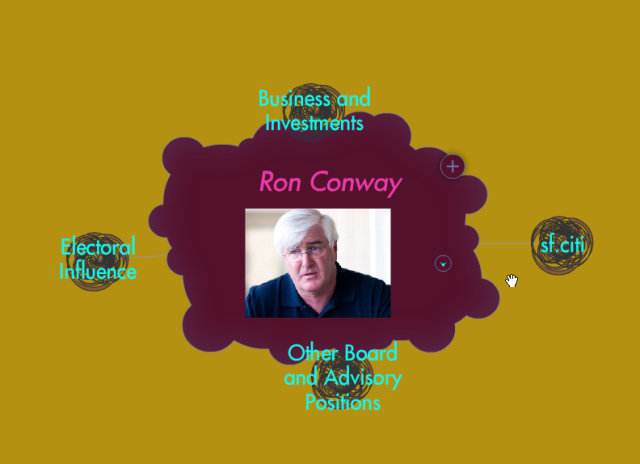By Tim Redmond
DECEMBER 8, 2014 – There’s not a single elected Republican in San Francisco government (the last GOP member to hold any elective office from this Democratic city, BART Board member James Fang, lost his job in November).
But the most powerful person at City Hall, some would argue, was a Republican for most of his life, has a Republican consultant running his political operation, and gave $50,000 to the presidential campaign of George W. Bush, who may go down in history as the worst president of the post-War era.
His name is Ron Conway. He’s a pal of Mayor Ed Lee, he played a key role in electing David Chiu to the state Assembly – and he’s not afraid to throw his political weight around.
Now the Anti-Eviction Mapping Project has put together a detailed profile of Conway’s financial, business, and political connections in an easy-to-use format. You can track his investments, his political contributions, his lobbying efforts, and just about every major story that’s been written about him and his close ties with the mayor.
This guy really thinks he runs San Francisco. He needs to be watched and held accountable the same as any politician.
So San Francisco has $22 million more money than the city expected. That’s good news, I suppose; we live in boom times, and one would think that a tiny bit of the vast wealth in this town would trickle down to the public coffers. In fact, with all the money that the tech companies are making, and all the impacts that they’re creating on the city, one might think that $22 million is, well, a pretty dinky sum.
It will, for example, just barely cover the cost of Sup. Scott Wiener’s measure to link Muni funding to population growth. The cost of Muni goes up when more people move here and developers build more office space so more people come here during the day, even if they live somewhere else.
In theory, one would think that the developers who are making great gobs of money from new housing and office space would have to pay the costs of additional Muni service, instead of sticking the rest of us with that tab. (Oh, and if the extra property taxes from new development were enough to cover all the costs, how come we have only $22 million, which covers just Muni – not water and sewer, not police and fire, not affordable housing needs or anything else?)
I think what we see in these figures is proof that the added revenue that comes from growth in San Francisco doesn’t pay the cost of servicing that growth. If it did, we’d be awash in cash right now, with a surplus allowing us to fund Muni and a few thousand affordable housing units and more ambulances and everything else we need to meet the needs of an expanding population.
Instead, we’re going to scramble to figure out which of the multitude of needs that money can go to (partially) fill.
I think Sup. David Campos is right – while Muni’s critically important, the number one need right now is affordable housing. Again, the facts before us, the real data, shows that the private-sector housing market has utterly failed to provide for the city’s needs:
From 2007 to the middle of this year, 19,267 new units were built, 12,726 of them for the rich. Only 1,213 were priced for the middle class and 5,328 for the poor.
That means only six percent of new housing is affordable to middle-class workers.
Building affordable housing is expensive. What if we took the $22 million and used it to buy existing rent-controlled housing and take if off the private market forever? That might be more efficient.
In the meantime, let us remember: The only ones who are really coming out ahead in San Francisco today are the tech companies, the landlords and the developers. The city’s getting a pittance.
But I suppose that’s the way Ron Conway, our Bush-loving plutocrat, likes it.





